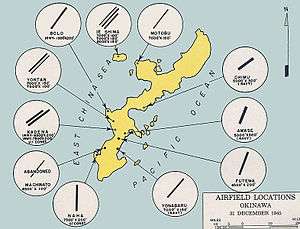United States Army Air Forces in Okinawa
United States Army Air Force in Okinawa and Ie Shima .svg.png) .svg.png) .png) | |||||||
|---|---|---|---|---|---|---|---|
| Part of World War II | |||||||
 Location of USAAF airfields on Okinawa and neighboring islands, 31 December 1945 | |||||||
| |||||||
The Battle of Okinawa was the last major ground battle between the armed forces of the Empire of Japan and the United States of the Pacific War.
United States Army and United States Marine Corps ground forces landed on the island on 1 April 1945 at 08:30 am. The Battle of Okinawa lasted 83 days until 22 June, when the island was declared secured. The defense of the island was divided into three strong Japanese lines where hidden guns, machine guns and bunkers covered approaches and fields. Soldiers on the ground fought a grueling battle to occupy the island. The United States Navy and its support ships were larger in numbers than those at Normandy in June 1944, and were attacked repeatedly by Japanese kamikaze aircraft, sinking and damaging a significant number of vessels. It was a battle in which more than 12,000 American and 70,000 Japanese soldiers lost their lives. In addition, it is estimated that between 100,000 and 150,000 Okinawan civilians were also killed during the battle.
Airfield development
With the conquest of Okinawa, the United States obtained a key location to launch an invasion of the Japanese Home Islands, planned for November 1945. Base development plans were drawn up to provide for 18 runways on Okinawa and three on Ie Shima, instead of the eight and two originally planned respectively for the two islands. Construction of airfields on Okinawa was to center on the provision of facilities for B-29 Superfortress operations, while Ie Shima was to be developed primarily as a base for Very Long Range (VLR) P-47N Thunderbolt and P-51H Mustang fighter escorts.
Work on fighter airfields was initially given the highest priority in order to provide land-based air cover during the assault. By 10 April Kadena and Yontan airfields had been reconditioned for successful operations. By the end of May construction was in progress on ten different bomber and fighter runways on Okinawa and Ie Shima. Of these only the fields at Yontan and Kadena and one of the fighter runways on Ie Shima were near completion. The first American runway built on Okinawa was the 7,000-foot medium bomber runway at Yontan, completed on 17 June. By the end of June a 7,500-foot VLR strip at Kadena was 25 percent complete, two 5,000-foot fighter runways at Awase and Chimu for Navy use were ready for operation, an 8,500-foot VLR runway at Bolo Point was 15 percent complete, and construction was under way for VLR and a medium-bomber runway at Futema.
By the end of the Okinawa campaign the full realization of the plans for the development of major air bases in the Ryukyus lay in the future. Most of the airfields would not be completed for two or three months, although fighters were flying from some to attack Kyūshū.
USAAF combat units assigned to Okinawa
Fifth and Seventh Air Force tactical fighter-bomber aircraft were based on Okinawa, along with B-24 Liberators and B-25 Mitchell bombers to be employed in tactical bombing missions. In addition, the Eighth Air Force was reassigned from England to establish a second strategic air force to complement the Twentieth Air Force based in the Mariana Islands with B-29s. The Eighth also controlled long-range P-47N and P-51H Fighter groups to provide escort to the very heavy bombers.
- # indicates units based on Ie Shima
|
Army Air Forces, Pacific Ocean Areas
Fifth Air Force
|
Seventh Air Force L Headquarters, Seventh Air Force, Army Air Forces, Pacific Ocean Areas, 12–13 July 1945
Eighth Air Force
|
Combat airfields
|
|
Epilogue
The Battle of Okinawa was a critical turning point that served as a catalyst for the world-changing decision that followed. It helped spur President Truman's decision to attack Hiroshima and Nagasaki with atomic bombs, because the casualty numbers at Okinawa indicated a projected one million deaths for the planned invasion of Japan.
At Okinawa, American military forces all but destroyed Japan's Imperial Army in the Pacific. The sinking of Japan's last major naval vessels in the battle and the elimination of almost all available fuel supplies in Japan by the Twentieth Air Force's destruction of most fuel storage and oil refineries forced an end to the Japanese war machine's capability to engage in battle effectively.
To the Japanese, the defeat on Okinawa convinced the civilian leadership that defeat was inevitable. Their arguments convinced Emperor Hirohito to oppose the pro-war leaders in his government, and after Hiroshima and Nagasaki, to accept the Potsdam Declaration's demand for Japan's unconditional surrender.
Two months later, on 15 August 1945, Imperial Japan surrendered to the Allied forces, ending the war in the Pacific, and World War II came to an end. The massive air armada assembled by the USAAF for the invasion of Japan was never used in combat; it was instead partially used as an occupation force, but mostly demobilized and inactivated in 1945 and 1946.
See also
- United States Army Air Forces in Australia
- United States Army Air Forces in the Central Pacific Area
- United States Army Air Forces in the South Pacific Area
- United States Army Air Forces in the South West Pacific Theatre
References
![]() This article incorporates public domain material from the Air Force Historical Research Agency website http://www.afhra.af.mil/.
This article incorporates public domain material from the Air Force Historical Research Agency website http://www.afhra.af.mil/.
- Maurer, Maurer (1983). Air Force Combat Units Of World War II. Maxwell AFB, Alabama: Office of Air Force History. ISBN 0-89201-092-4.
- Maurer, Maurer (1969). Combat Squadrons of the Air Force, World War II, Air Force Historical Studies Office, Maxwell AFB, Alabama. ISBN 0-89201-097-5